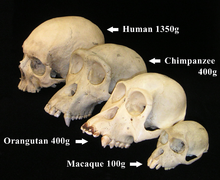Biological anthropology

Biological anthropology, also known as physical anthropology, is a scientific discipline concerned with the biological and behavioral aspects of human beings, their related non-human primates and their extinct hominin ancestors. It is a subfield of anthropology that provides a biological perspective to the systematic study of human beings.[1]
Mitochondrial DNA and Human Migrations
[edit | edit source]Mitochondrial DNA (mtDNA)
[edit | edit source]Mitochondrial DNA (mtDNA) is a circular double strand molecule which has a length of 15-20 kilobases in animals. In most species it has the same 37 genes that codify for 13 proteins, 2 ribosomal RNAs and 22 transfer RNAs (fig. 1).

The human mtDNA was the first mitochondrial genome sequenced. This first complete sequence was called Cambridge Reference Sequence (CRS).
This mtDNA is composed of 16,569 base pairs (bp) with their genes distributed between the H chain (high) and the L chain (light). With the exception of the Control Region (D-loop) which has regulatory functions and a 9 bp region called V Region, all the rest of the genome consists in coding DNA.
In the last 30 years, the mtDNA has been widely used in human evolution studies as a consequence of its particular characteristics that make it an ideal and useful tool.
Because of its non-coding nature, the Control Region exhibits the highest mutation rate in the mitochondrial genome. Several studies have demonstrated the strictly maternal inheritance of mtDNA, a phenomenon which represents an enormous advantage because it allows tracing related matrilineages along time without all inherent nuclear DNA problems like recombination and biparental inheritance [2].
Mutations and Haplogroups
[edit | edit source]
Because mtDNA does not recombine, the only changes in the genome are exclusively a consequence of occurring mutations which accumulate sequentially, producing less related DNA molecules which constitute independent lineages defined as haplotypes [3]. The set of haplotypes characterized by one or more mutations denoting a common ancestral origin is called haplogroup [4].
It is possible to determine these haplogroup-specific mutations and assign the continental origin of a particular matrilineage. The development of the Polymerase Chain Reaction (PCR) resulted in the amplification and analysis of thousands of mtDNA samples from very different origins allowing the quantification of the relative mitochondrial diversity between continents, defining haplogroups and supporting the African origin of modern humans [5]
The construction of a complete phylogeny of the human mtDNA was possible when complete sequences of the genome were obtained by sequencing. It is represented in a phylogenetic tree (fig.2).

Several human-migration hypotheses based on mtDNA studies agree in locating the origin of Homo sapiens in Africa around 140-200 thousand years ago. L0 would be the most ancient haplogroup from which derive L1-L6 haplogroups [6]
L3 could have arisen in East Africa and spread through the rest of the continent. It gave origin to M and N, the only haplogroups that populated the rest of the world. L0-L6 haplogroups remained restricted to Africa until the modern age.
From the M and N haplogroups emerged the rest of the haplogroups and sub-haplogroups spread all over the world (fig.3).
See also
[edit | edit source]References
[edit | edit source]- ↑ Wikipedia: Biological anthropology
- ↑ Pakendorf, B. and M. Stoneking (2005). "Mitochondrial DNA and human evolution." Annu Rev Genomics Hum Genet 6: 165-83.
- ↑ Maca-Meyer, N., A. M. Gonzalez, et al. (2001). "Major genomic mitochondrial lineages delineate early human expansions." BMC Genet 2: 13.
- ↑ Torroni, A., A. Achilli, et al. (2006). "Harvesting the fruit of the human mtDNA tree." Trends Genet 22(6): 339-45.
- ↑ Wallace, D. C. (1999). "Mitochondrial diseases in man and mouse." Science 283(5407): 1482-8.
- ↑ Kivisild, T., M. Reidla, et al. (2004). "Ethiopian mitochondrial DNA heritage: tracking gene flow across and around the gate of tears." Am J Hum Genet 75(5): 752-70.